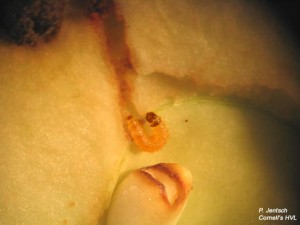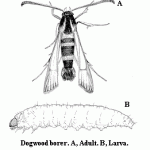 Dogwood borer larva (DWB) are now emerging from eggs laid in late June and early July, reaching peak emergence next week. If DWB are infesting young plantings and have not yet received control measures, now is a good window for borer management using directed trunk application, Lorsban being the most effective application option.
Dogwood borer larva (DWB) are now emerging from eggs laid in late June and early July, reaching peak emergence next week. If DWB are infesting young plantings and have not yet received control measures, now is a good window for borer management using directed trunk application, Lorsban being the most effective application option.
Its hard to find a single orchard of slender spindle high density apple on M-9 rootstock free of dogwood borer (DWB), Synanthedon scitula. It’s not only present throughout the Hudson to the Champlain Valley, and eastern shores of Lake Champlain Vermont, but its reducing the productivity of young plantings, adding to tree stress that puts the planting at risk for secondary infection from disease and Black Stem Borer.
However, it’s rare to find Dogwood borer on healthy trees, free of rooting initials, scaling bark or pruning wounds in apple trees. The adult prefers to lay eggs on burrknot of rootstock varieties that promote rooting initials, giving rise to DWB adult egg laying and larval feeding within this susceptible area of the tree. The M-9 rootstock is quite susceptible to burrknots, very sensitive to fireblight and its shallow root system drought sensitive. Its near relative, Bud-9 has much less burrknot initials, having greater resistance to fireblight and Phytopthera & quite cold hardy. The detailed publication of the NC140 rootstock trial provides descriptions of rootstock and interstems selection strengths and weaknesses. 

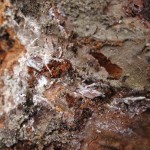
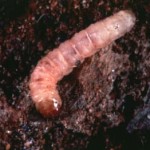

The American plum borer larva (APB), Euzophera semifuneralis (Walker), are also found on apple in habitats similar to those preferred by the dogwood borer. Borers can be monitored by checking under tree guards in the spring to locate active infestations as guards applied to newly planted trees encourage adult egg laying and larval presence. The larvae size of the two species are similar. DWB larva are white to cream-colored, with one row of crochets on the abdominal prolegs, while the APB larva is dusky purple to gray in color, and has two rows of crochets on the prolegs. Pheromone traps can be used to estimate the timing of peak flight in the Northeast.
Adult emergence of APB begins in early June and continues into early September, peaking in mid July. Traps should be placed at 4 feet above the ground for optimum captures.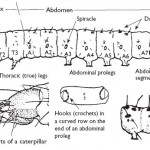
If DWB larva are found in burrknots of young trees, trunk applications of Lorsban should be applied using a course directed application to tree trunks at the earliest window to reduce the present larval population. Further infestation by adult egg laying and larval emergence can be reduced with directed applications over the next two weeks.
European corn borer: We observed our first trap captures of the adult European corn borer on the 25th of May in New Paltz, NY with increasing Z strain over the past week.

Wallkill View Farms, New Paltz, NY
The Eastern strain of European corn borer has a wide host range, attacking robust herbaceous plants with a stem large enough for the larvae to enter. Some of the common weeds infested include barnyardgrass, Echinochoa crus-galli; beggarticks, Bidens spp.; cocklebur, Xanthium spp.; dock, Rumex spp.; jimsonweed, Datura spp.; panic grass, Panicum spp.; pigweed, Amaranthus spp.; smartweed, Polygonum spp.; and others.
There are reports that weather influences European corn borer survival. Heavy precipitation during egg hatch is sometimes an important mortality factor. Low humidity, low nighttime temperatures, and heavy rain and wind are detrimental to moth survival and oviposition. However, like most insect pests, they seem to thrive during unlikely weather scenarios in years past.
High temperature surrounding pyrethroid applications will reduce the efficacy of application against the ECB. The pyrethroid class of chemistry is more easily detoxified in higher temperatures then other classes of insecticides. (see Effect of Temperature on on ECB Efficacy (Tony Shelton, NYSAES).


Typical examples of ECB feeding on apple is similar to that of Oriental Fruit Moth on apple with frass and entry under petiole or side shoot of new shoots.
Delegate 25WG is labeled and very effective against ECB on newly planted trees.
1. Musser, Fred R and Anthony M Shelton. The influence of post-exposure temperature on the toxicity of insecticides to Ostrinia nubilalis (Lepidoptera: Crambidae)
Pest Management Science Volume 61, Issue 5, pages 508–510, May 2005

